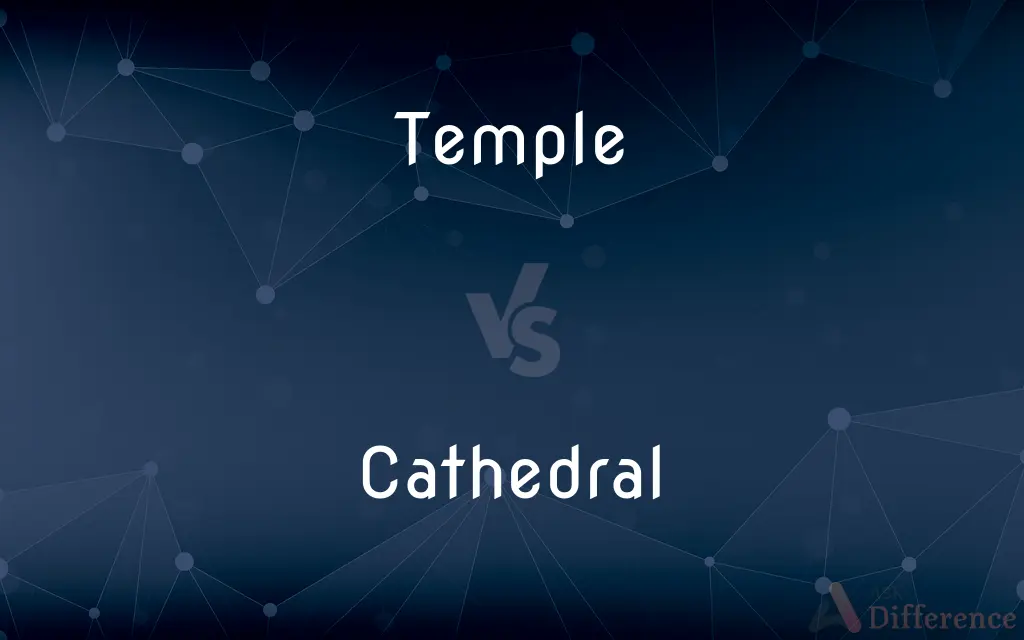Temple vs. Cathedral — What's the Difference?
By Tayyaba Rehman & Maham Liaqat — Updated on February 29, 2024
A temple is a place of worship for various religions, associated with non-Christian faiths, focusing on rituals and ceremonies. A cathedral is a Christian church that serves as the principal church of diocese, where the bishop's official seat is located.

Difference Between Temple and Cathedral
Table of Contents
ADVERTISEMENT
Key Differences
Temples serve as places of worship and religious activities across many faiths, including Hinduism, Buddhism, Judaism, and others. They are central to the religious and spiritual life of the communities they serve, hosting rituals, prayers, and ceremonies specific to their traditions. Cathedrals, specifically within Christianity, are not just places of worship but also the administrative center of a diocese. They house the cathedra, or bishop's seat, symbolizing the bishop's authority and the cathedral's importance.
Temples are architecturally diverse, reflecting the cultural and spiritual nuances of the religions they represent. Cathedrals are often noted for their grand architectural design, including elements like large bells, extensive use of stained glass, and significant art pieces, aimed at glorifying the Christian faith.
The primary distinction between temples and cathedrals lies in their religious context and function. While temples may cater to a variety of religious practices and serve as a general place for worship and ritual across multiple religions, cathedrals are specifically Christian, with a particular role in the church hierarchy and ecclesiastical authority.
The architectural styles of temples and cathedrals can significantly differ, reflecting the cultural and historical contexts of their respective religions. Temples often incorporate designs meant to symbolize the universe or provide a dwelling place for deities, while cathedrals might emphasize height and light, aiming to inspire awe and direct attention heavenward, symbolizing the Christian concept of salvation and divinity.
Despite these differences, both temples and cathedrals play crucial roles in the spiritual and community lives of their adherents. They serve as centers for worship, celebration, and mourning, and as symbols of faith and identity for the communities they represent.
ADVERTISEMENT
Comparison Chart
Definition
A place of worship in various religions, focusing on rituals.
A principal Christian church in a diocese, seat of a bishop.
Associated Religions
Hinduism, Buddhism, Judaism, etc.
Christianity
Architectural Features
Reflects cultural and religious nuances, diverse designs.
Grand design, stained glass, cathedra, often Gothic style.
Function
Religious rituals, ceremonies, and community gatherings.
Worship, ecclesiastical authority, community events.
Symbolism
Often symbolizes the universe or houses deities.
Represents Christian salvation, heavenward focus.
Location in Religious Hierarchy
Not applicable or varies by religion.
Central in the diocesan structure, housing bishop's authority.
Compare with Definitions
Temple
Architecturally diverse, reflecting its religious and cultural context.
The ancient Greek temple features classical columns and pediments.
Cathedral
Symbolizes the Christian faith's traditions and teachings.
The cathedral's architecture reflects Gothic influences, emphasizing verticality and light.
Temple
Central to the spiritual life of its adherents, facilitating direct communion with the divine.
Pilgrims visit the temple seeking blessings.
Cathedral
Hosts significant religious ceremonies and diocesan events.
The new bishop's installation ceremony is at the cathedral.
Temple
Often serves as a community gathering place for celebrations.
The Buddhist temple hosts the annual Vesak procession.
Cathedral
Serves as a center for worship, administration, and community support.
Community outreach programs are coordinated through the cathedral.
Temple
May contain altars, statues, or other symbols significant to its faith.
The temple's inner sanctum houses a revered deity statue.
Cathedral
The main church of a diocese, containing the bishop's official seat.
The cathedral's spire is a landmark of the city.
Temple
A temple (from the Latin templum) is a building reserved for spiritual rituals and activities such as prayer and sacrifice. Religions which erect temples include Hinduism, Buddhism, Sikhism, Jainism, Christianity (whose temples are typically called churches), Islam (whose temples are called mosques), Judaism (whose temples are called synagogues), and ancient religions such as the Ancient Egyptian religion.
Cathedral
Features architectural elements aimed at inspiring awe and reverence.
Stained glass windows depict biblical stories in the cathedral.
Temple
A building devoted to the worship of a god or gods.
Cathedral
A cathedral is a church that contains the cathedra (Latin for 'seat') of a bishop, thus serving as the central church of a diocese, conference, or episcopate. Churches with the function of "cathedral" are usually specific to those Christian denominations with an episcopal hierarchy, such as the Catholic, Anglican, Eastern Orthodox, and some Lutheran churches.
Temple
A building dedicated to religious ceremonies or worship.
Cathedral
The principal church of a bishop's diocese, containing the episcopal throne.
Temple
Temple Either of two successive buildings in ancient Jerusalem serving as the primary center for Jewish worship.
Cathedral
A large, important church.
Temple
(Judaism) the place of worship for a Jewish congregation
Cathedral
Something that resembles a cathedral, as in grandeur or authority.
Temple
A sacred place for worship and rituals in various religions.
The Hindu temple is adorned for the Diwali festival.
Cathedral
Of, relating to, or containing a bishop's throne
A cathedral church.
Cathedral
The principal church in a diocese, so called because in it the bishop has his official chair (Cathedra) or throne.
Cathedral
Any large and important church
Cathedral
The principal Christian church building of a bishop's diocese
Common Curiosities
Are all temples non-Christian?
While the term "temple" is commonly associated with non-Christian religions, some Christian groups also use it, particularly for buildings considered especially sacred.
What distinguishes a temple from a cathedral?
The primary distinction lies in their religious context and function, with temples serving various religions and focusing on rituals, while cathedrals are Christian churches with a specific ecclesiastical role.
Can cathedrals be found in all Christian denominations?
Cathedrals are prevalent in many, but not all, Christian denominations, particularly those with episcopal governance, such as Roman Catholic, Anglican, and some Orthodox and Lutheran churches.
Do all religions have temples?
Not all religions use the term "temple" for their places of worship, and the concept may vary significantly across different faiths.
Are there any specific rituals or ceremonies unique to cathedrals or temples?
Yes, both cathedrals and temples host rituals and ceremonies unique to their religious traditions. Cathedrals may host specific Christian sacraments and liturgical celebrations, such as ordinations and confirmations, that highlight their role in the diocese. Temples may conduct rituals, offerings, and festivals unique to their faith, such as puja in Hinduism or Torah readings in Judaism, reflecting their cultural and religious practices.
What role do temples and cathedrals play in their communities?
Both serve as centers for worship and spiritual activities, play significant roles in religious festivals and life events, and act as symbols of faith and identity for their communities.
How do the roles of priests in temples compare to those of clergy in cathedrals?
Priests in temples and clergy in cathedrals both perform religious rites, lead worship, and offer spiritual guidance. However, their specific roles, titles, and duties can vary significantly based on the religious traditions and hierarchical structures of their respective faiths.
Why are cathedrals often larger and more ornate than other churches?
Cathedrals serve as the principal church of a diocese and the seat of the bishop, necessitating space for diocesan ceremonies and symbolizing the spiritual authority and importance of the church. Their size and ornamentation reflect their ceremonial, administrative, and symbolic roles.
Is the architectural style of cathedrals uniform across Christianity?
No, cathedral architecture varies greatly, reflecting different historical periods, regional styles, and denominational preferences, though Gothic architecture is notably prevalent in many European cathedrals.
Do temples have a similar hierarchical significance in their religions as cathedrals do in Christianity?
The hierarchical significance of temples varies widely among religions. In some faiths, certain temples hold special religious significance due to their historical, spiritual, or mythological associations, rather than a structured ecclesiastical hierarchy akin to that of cathedrals in Christianity.
Can a building be both a temple and a cathedral?
Typically, a building serves as either a temple or a cathedral based on its religious affiliation and function. However, historical circumstances have led to some buildings being repurposed, but they usually retain or adopt the designation that aligns with their current function and religious affiliation.
Share Your Discovery

Previous Comparison
Sophisticated vs. Classy
Next Comparison
Gateway vs. BridgeAuthor Spotlight
Written by
Tayyaba RehmanTayyaba Rehman is a distinguished writer, currently serving as a primary contributor to askdifference.com. As a researcher in semantics and etymology, Tayyaba's passion for the complexity of languages and their distinctions has found a perfect home on the platform. Tayyaba delves into the intricacies of language, distinguishing between commonly confused words and phrases, thereby providing clarity for readers worldwide.
Co-written by
Maham Liaqat














































